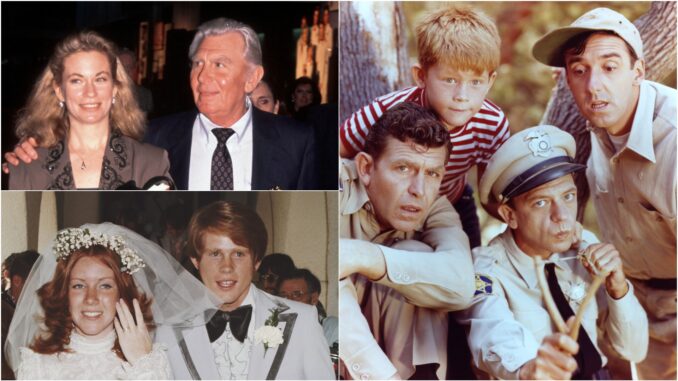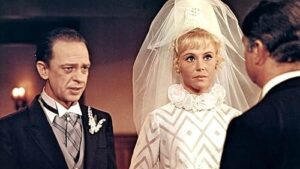
When you stroll through the charming fictional town of Mayberry in the classic 1960s sitcom “The Andy Griffith Show,” one thing becomes strangely clear: very few people are married. For a show rooted in Americana and small-town values, you’d expect to see more happy couples settling down. But in Mayberry, weddings are few, engagements are fleeting, and married couples are nearly non-existent.
So why weren’t many people married in Mayberry? Was it a creative choice, a reflection of the times, or something else entirely? Let’s take a nostalgic—and surprisingly revealing—walk down Mayberry’s quiet streets and explore the real reasons behind the show’s chronic bachelorhood.
Setting the Scene – What Was ‘The Andy Griffith Show’?
“The Andy Griffith Show” ran from 1960 to 1968, delivering a homespun look at life in the fictional town of Mayberry, North Carolina. Sheriff Andy Taylor (played by Andy Griffith) was the wise, kind-hearted lawman raising his young son, Opie, with the help of Aunt Bee and a colorful supporting cast that included the unforgettable Barney Fife.
A Town Full of Characters—But Few Couples
You had a barber, a mechanic, a schoolteacher, and a deputy—but where were all the husbands and wives? Outside of a few married background characters (like Otis the town drunk, who occasionally mentioned his wife), Mayberry seemed stuck in a perpetual state of dating and courtship.
Andy Taylor—The Eternal Bachelor
Andy’s Love Life: Always in Progress, Never a Destination
Despite being the lead character, Andy never tied the knot during the show’s entire run. He dated a few women—most notably Helen Crump—but their relationship never evolved past courtship during the original series.
Why? Many believe it was intentional. Andy Griffith himself thought marriage would make the character “less interesting.” Settling Andy down would’ve changed the dynamic of the show, possibly making it harder to insert new romantic tension or light-hearted flirtations.
Barney Fife—All Talk, No Wedding Bells
The Curious Case of Thelma Lou
Barney Fife, played brilliantly by Don Knotts, had a steady girlfriend named Thelma Lou. They flirted, argued, and dated for years—but never got married on the original show. In fact, Thelma Lou vanished without much explanation after a while.
It wasn’t until a reunion movie decades later (“Return to Mayberry”) that the two finally tied the knot. By then, the moment felt more like a nostalgic nod than a payoff for long-standing fans.
Was Mayberry a Fantasy World Frozen in Time?
No Change, No Conflict, No Commitment?
One reason many characters remained single is because “The Andy Griffith Show” thrived on consistency. It was a slice-of-life series designed to be cozy, unchanging, and reliably sweet. Weddings bring change—and change brings conflict.
The producers knew that keeping everyone in a kind of suspended animation preserved the show’s comforting atmosphere. Marriage could have shifted the tone too far into realism or emotional drama, which wasn’t the goal.
The Show’s Core Themes Didn’t Require Romance
Family, Friendship, and Community Took Center Stage
The show emphasized moral lessons, community values, and the bond between Andy and Opie. Romance existed but was never the main event. Even Helen Crump, Andy’s longest-running love interest, was primarily shown as Opie’s teacher, not Andy’s romantic partner.

Behind-the-Scenes Decisions Influenced the Narrative
Andy Griffith’s Vision of the Show
Andy Griffith wanted the show to avoid becoming another domestic sitcom. He deliberately kept Andy Taylor as a widower raising his son to give the show a unique angle.
His vision steered the writers away from creating typical husband-and-wife setups. Instead, they focused on quirky townsfolk and lighthearted plots that didn’t require a married couple to carry the show.
TV Censorship and Network Expectations in the 1960s
In the early 1960s, networks had strict rules about portraying marriage and intimacy. Shows had to be squeaky clean. Writers often avoided marriages to sidestep potential complications—like how to portray a couple living together without implying anything too suggestive.
Keeping characters single was simply easier. It meant fewer rules to follow and more flexibility in storytelling.
Romance Did Exist… Just Very Gently
Dating Was Often Comedic, Not Emotional
Characters like Goober and Gomer had crushes, but their storylines were usually played for laughs. Romance wasn’t absent—it just wasn’t central or emotional. It existed more as background noise than as a focus.
Did Mayberry Reflect 1960s America or Escape It?
You could argue that Mayberry wasn’t meant to mirror real life—it was more like an escape from it. The early 1960s were filled with social upheaval, civil rights protests, and political unrest. Mayberry offered a place where none of that existed.
Part of that escapism meant avoiding the complexities of adult relationships, marriage included.
The Exception to the Rule—Floyd the Barber’s Hints of Marriage
There were whispers about Floyd the barber being married—he occasionally referenced a wife. But she was never shown on screen. This could’ve been another creative workaround: mentioning marriage to build depth without actually portraying it.
The Female Characters Were Independent
Mayberry’s women were strong in their own right—Helen Crump, Thelma Lou, and even Aunt Bee had personalities and lives that didn’t revolve around chasing marriage.
This subtle nod to independence might have been more progressive than it appears at first glance. The women didn’t need to be married to matter.
Viewer Expectations Played a Role
Fans tuned in for laughs, life lessons, and lovable characters—not romantic arcs. The writers knew this and tailored the content accordingly. Marriage simply wasn’t on the audience’s wish list.
Spin-Offs Didn’t Prioritize Marriage Either
“The Andy Griffith Show” led to several spin-offs, like “Gomer Pyle, U.S.M.C.” and “Mayberry R.F.D.” While those shows sometimes dabbled more in romance, they also largely avoided centering the narrative around married life.
A Small Town Without Wedding Bells—What It Really Meant
Mayberry’s marital drought wasn’t an oversight—it was a choice. A deliberate one. It kept the town feeling frozen in a golden era, untouched by time, age, or change. It preserved the charm, the simplicity, and the innocence.
And maybe that’s why it still works today. We don’t tune in to watch people get married. We tune in to remember when life felt just a little bit easier.
Conclusion: The Comfort of Staying Single in Mayberry
In a world filled with sitcom weddings and will-they-won’t-they drama, “The Andy Griffith Show” stood apart. Its characters didn’t need rings or ceremonies to be compelling. Mayberry wasn’t about grand romance—it was about simple moments, small-town values, and gentle humor.
By keeping its characters mostly single, the show preserved its timeless quality. It created a world where change wasn’t necessary—and maybe that’s what made Mayberry feel like home.
FAQs
1. Did Andy Taylor ever get married on the show?
No, Andy Taylor remained unmarried throughout the entire run of “The Andy Griffith Show.” He dated Helen Crump, but they didn’t marry until the spin-off movie “Return to Mayberry” in 1986.
2. Why didn’t Barney Fife marry Thelma Lou during the original show?
The writers never developed their relationship beyond dating. Don Knotts left the show in Season 5, and Thelma Lou’s character was written out. They finally married in the reunion movie.
3. Were there any married couples in Mayberry?
Only a few, mostly in passing references—like Otis mentioning his wife. Most main and recurring characters were single.
4. Was keeping characters single a creative decision?
Yes. Andy Griffith and the writers wanted the show to focus on community and personal growth, not romantic entanglements or domestic life.
5. Did viewers care that no one was married?
Not really. Fans embraced the show for its warmth, humor, and moral lessons. The lack of weddings didn’t hurt its popularity—in fact, it may have helped it stay timeless.
